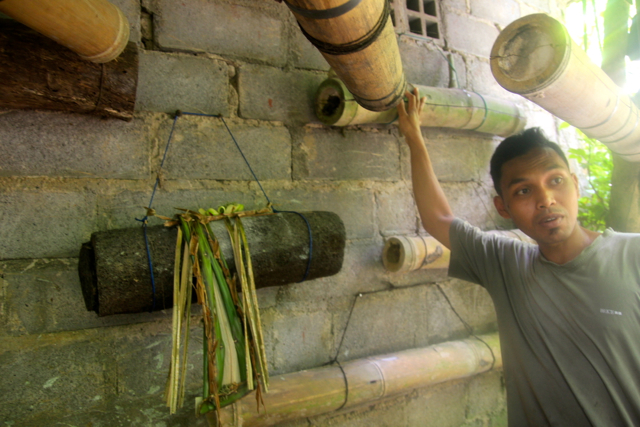- Residents of Tenganan in the hills of eastern Bali produced forestry regulations that predate the 11th century. The village still adheres to them.
- The local Aga people are trying to negotiate a balance between maintaining the environment and accommodating foreign tourists.
- According to a local regulation on collective ownership, individuals within the village can neither draw up deeds for local land nor transfer parcels to people outside the community.
Deep in the mountains of eastern Bali sits a traditional Aga village, whose inhabtants – legendarily the island’s first – still reside and abide by ancient ways.
Long before Indonesian independence, and even before the 11th century, when the fleeing courtiers of Java’s Hindu Majapahit dynasty landed in Bali, the village of Tenganan Pegringsingan had written forestry regulations. The edicts defined the forest as the 225-square-mile area of trees in these steep, 40-percent-grade hills.
According to the ancestral notes, the woods must be communally owned and managed, and cannot be sold or transferred to anyone outside the Aga community.
There are even oral and written regulations on hunting and woodcutting. Only dead branches can be collected, and no woodcutting is permitted, except with permission from customary leaders.
And today, residents old and young still honor these edicts, choosing to follow the written instructions of their ancestors instead of pushing forest resources to the brink.
Thirty-three-year-old Durpa Adnyana, for instance, makes a living collecting wild honey in self-designed, homemade bee houses he fashions from short lengths of bamboo. He collects sweet mango flower honey six times a year, and the tiny kele bees’ sour honey, favored by local shamans, twice a year.
In tune with the ancient conservation statutes, Durpa sets personal limits. “If six hives are ready for harvest, I will only take honey from two,” he explained. “To take more would be heartless to the bees.”

Though they have no Aga blood, Durpa’s family has lived in a bamboo cottage near the local forest for many generations. From the 60 beehives he tends to, Durpa can collect a liter of honey, worth 400,000 rupiah ($30), every harvest, giving him an average monthly income of 500,000 rupiah. Then, like many others in Tenganan trying to balance their respect for the ancestors and their need to earn money, Durpa moonlights as a guide for foreign tourists.
Visitors are fascinated with Tenganan’s unique architecture and layout. The village forest is beautiful and filled with trees and fruits necessary for the local community’s various ceremonies.
The Wisnu Foundation, which is helping the Tenganan develop its ecotourism industry, has recorded a variety of local vegetation. It counts 25 different wild tree species and four wild grass species. The community tends rice paddy and vegetable plots filled with corn, peanuts, chilies and long beans. In the orchards, the foundation notes that locals grow bananas, coffee, avocado, rambutan and pineapple.
Also unique to Tenganan is locals’ worship of the Hindu war god Indra instead of Vishnu, Brahma or Shiva. As a result, residents perform the famous mekare-kare ceremony annually, playing out mock battles with spiky pandan leaves. The connection to the war god runs deeper, too. Residents claim Indra’s very actions affect the structure of the village. Indra stays alert to approaching evil for them. He also protects the village fort and the four doors that represent the four wind directions.
Like Durpa, who makes a living off tourism to his unique hometown, I Nyoman Suwita mans the village’s volunteer donations post. Tenganan doesn’t require visitors to pay an entrance fee. But Suwita invites tourists to fill the guestbook and consider a volunteer donation for village upkeep.
Suwita is deeply involved with local ancestral knowledge. He can speak extensively about the famous pineapples of Karangasem regency, the annual influx of long-tailed macaques that fruit season attracts and the sacred rituals to ensure there is no conflict between wild primates and the community.

As a personal project, Suwita is creating a spatial plan for the village. His goal is to draw up a clear document that all Tenganan residents can agree on in case the government tries to convert the surrounding forests into industrial enterprises.
Bali’s 2010 regional spatial planning law states that protected areas can keep their function in preserving the living environment and natural resources. The goal is to protect water and land and ecosystem biodiversity.
The Wisnu Foundation said that there is one plot of land within the communal forest that is deeded to an individual named GG. But originally, all the land was owned and managed communally. To guard against other land being sold, the traditional village created a new regulation on the meaning of collective ownership.
Tenganan community leader I Nyoman Sadra, maintains that individuals within the village cannot draw up deeds for local land nor can they transfer parcels to people outside the community. Sadra retold of how one resident tried to certify land and use it as collateral for a bank loan.
“He got fined by the village,” Sadra confided.